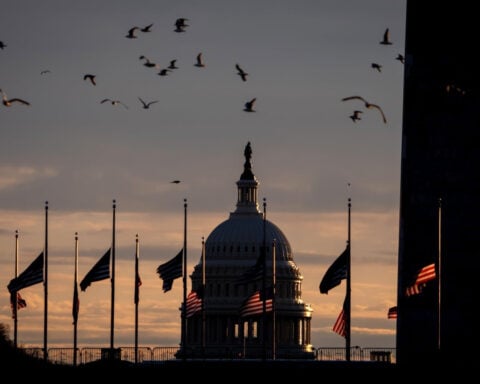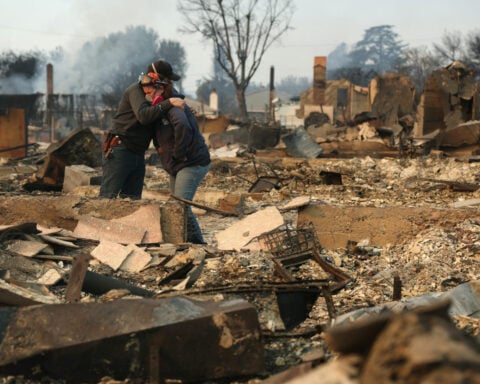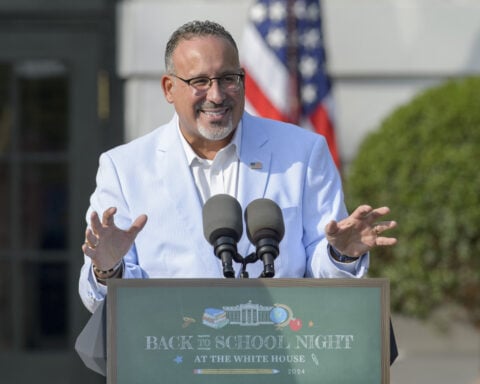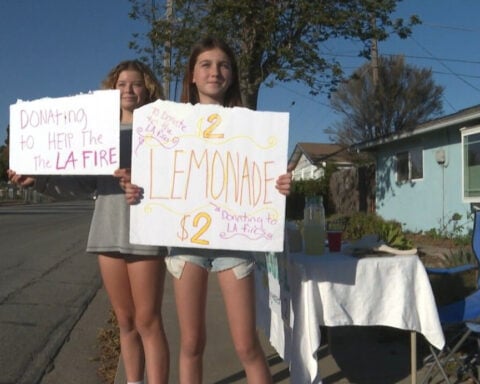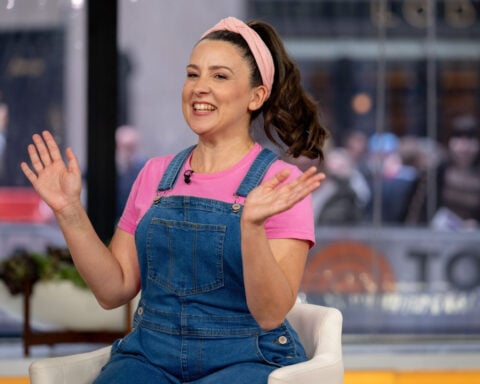(CNN) — Multicolored posters, white streamers and Palestinian flags made of paper decorate a tent in Deir al-Balah, central Gaza. School rucksacks stuffed with clothes, small pillows and floral blankets are strewn on the floor.
More than a dozen girls and boys sit cross-legged inside a makeshift classroom along the coastal region. Their eyes dart across a large whiteboard as they recite after their teacher, Oula Al Ghoul, who gently encourages her students. The sound of Israeli drones buzzes overhead – a stark reminder of the fighting that has engulfed the strip for more than 11 months.
“We have war, no schools… Yet the children are eager to learn,” Al Ghoul told CNN. She decided to set up a rudimentary classroom in the same tent in which she’s living, just to give some first-graders a chance to study.
“Even the parents come and ask about their children’s progress in writing, asking if they are improving.”
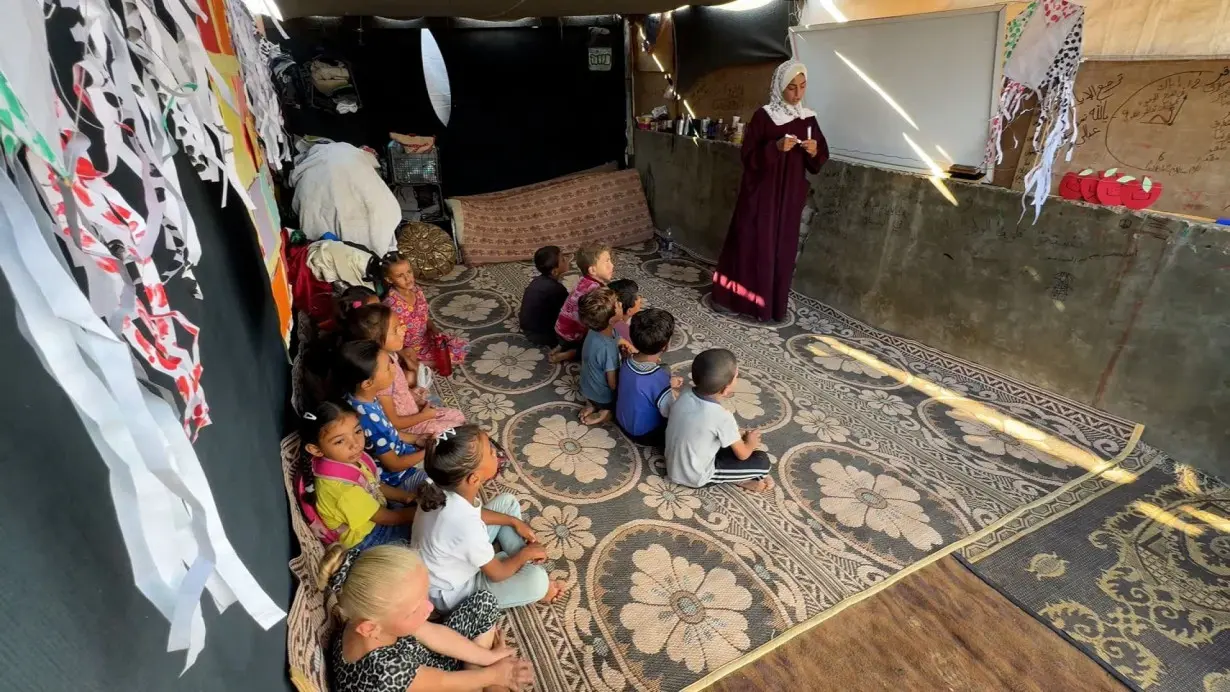
But her initiative is the exception. As children across the Middle East begin the new semester, those in Gaza will be unable to return to school. The Israeli offensive launched after the Hamas-led October 7 attacks has spawned a humanitarian crisis and halted educational services in the besieged enclave.
At least 45,000 first-graders in the Gaza Strip will be unable to start the school year, according to the United Nations’ children’s agency, UNICEF.
“The first graders join 625,000 children who have already been denied an entire school year,” and face the prospect of a second missed year of education, the agency said.
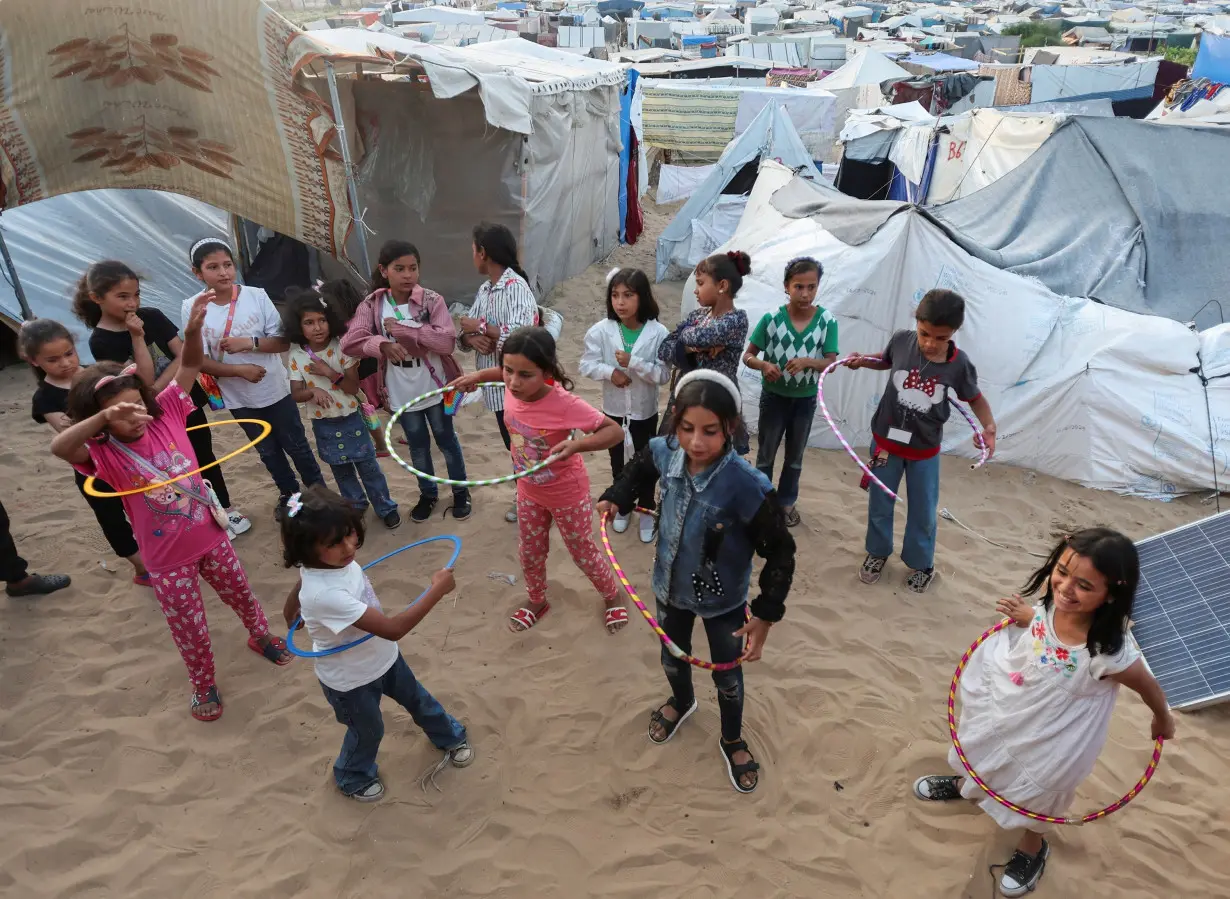
Israel’s bombing campaign has destroyed 123 schools and universities in Gaza, according to the Government Media Office (GMO) there. At least 11,500 students aged up to 18 and 750 teachers have been killed, the GMO reported on Monday.
Earlier this year, the UN accused Israeli forces of the “systematic obliteration” of the academic system in Gaza, citing independent experts, and called for the protection of schoolchildren. The IDF has said strikes on schools target Hamas militants and has previously insisted it take steps to minimize harm to civilians. Hamas has denied embedding fighters in civilian infrastructure.
Many schools have turned into makeshift shelters, as hundreds of thousands of people seek refuge from Israel’s bombardment. Several Palestinian children told CNN that days spent learning have been replaced by a struggle for survival. Some spend hours queueing for water or food aid, as Israel’s siege has depleted supplies. Aid workers say that displacement camps are crammed with children who have no safe space to play. .
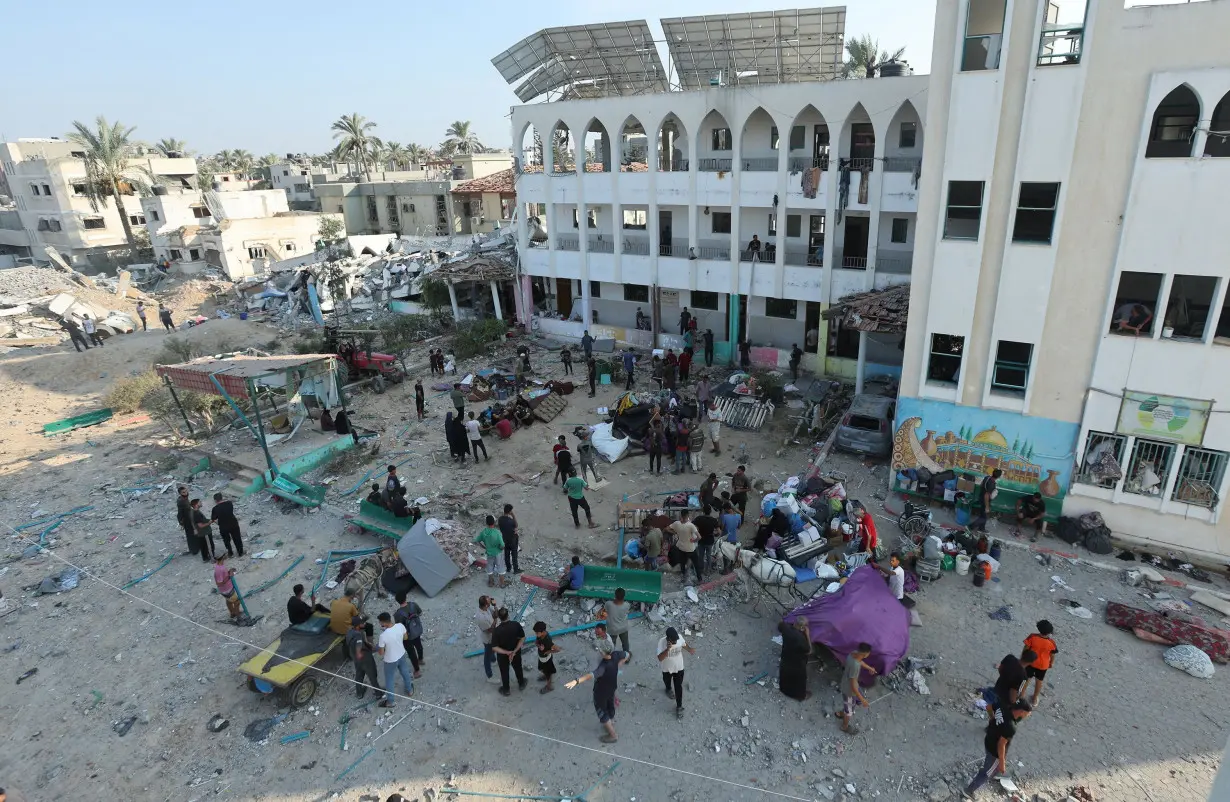
“I aspired to complete my studies and help my father feed my family,” said Raghad Ezzat Hamouda, a 19-year-old English literature student, displaced in Beit Lahia, northern Gaza. She told CNN on Friday that she had registered for her university course last fall – just before the hostilities erupted.
“The war destroyed all my ambitions and there was nothing left.”
Israel launched its military offensive on October 7 after the militant group Hamas, which governs Gaza, attacked southern Israel. At least 1,200 people were killed and more than 250 others abducted, according to Israeli authorities.
Israeli attacks in Gaza have since killed at least 41,182 Palestinians and wounded more than 95,000 others, the Ministry of Health there reported on Thursday. CNN cannot independently confirm the figures.
‘No schools, no books, nothing’
Dozens of Palestinian boys in dusty shoes carry empty jerry cans at a school which has become an improvised displacement shelter in Deir al-Balah. The sun beats down on their faces as they queue to collect water aid for their families.
At the school, run by the UN’s main agency for Palestinian humanitarian relief, UNRWA, children clamor for scant resources. Flies swarm between lines of displaced people, who are scattered between rows of tents, washing lines and old mattresses, inside the sprawling facility. The Israeli offensive in Gaza has displaced 1.9 million people, according to the UN – almost the entire population.
“We used to study, attend classes, do homework, and our lives were happy,” Maryam Shtawi, a young girl staying in the shelter, told CNN on Monday. “Because of the war, we were displaced, and there is no more education, nothing else – no studies. Our lives have turned into fetching water and gathering food. I want to learn.”
Nine-year-old Sajid told CNN he should have been starting fourth grade. “There are no more schools to learn in. Schools have become shelters for displaced people,” he said. “Now, we go and fetch water and buy things from the market. We no longer study. If I had stayed in school, I would have grown up to become a famous doctor.”
There’s no guarantee of safety for those sheltering in schools. At least 70% of schools run by UNRWA have been hit during the war – 95% of which were being used as shelters for displaced people – the agency reported on September 9.
On Wednesday, at least 18 people, including UNRWA staff, were killed in an Israeli airstrike on a UN school-turned-shelter in the Nuseirat camp in central Gaza, according to the Gaza Civil Defense and hospital officials.
The IDF claimed the school “was used by Hamas terrorists to plan and execute terrorist attacks against IDF troops and the state of Israel.” UNRWA said that their employees were teachers. UN Secretary-General Antonio Guterres described Israeli strikes on schools as “dramatic violations of international humanitarian law.”
Children have also been uprooted from one shelter to another, parents told CNN. The lack of stability or routine will compound psychological trauma for children who have witnessed scenes of bloodshed, lost loved ones or been orphaned by the war, according to UNICEF.
“The students’ situation is tough; they need to be learning right now… Unfortunately, none of the students can write. There are no schools, no books, nothing,” said Mohammad Masoud, a teacher. “Instead of being in their classes or universities, students are either selling on the streets or trying to help their families by standing in line for water or food.”
Meanwhile, at least 19,000 children have been separated from their parents or caregivers, the UN reported in August.
‘They are literally wading through rubbish’
Further south, in Al-Mawasi, Khan Younis, children run barefoot through the littered streets, according to a relief worker in the sprawling coastal town.
Some search through mounds of waste for items they can resell, said Liz Allcock, head of protection at the UK-based NGO Medical Aid for Palestinians (MAP).
“There are children everywhere,” Allcock said on Friday. Her testimony was relayed to CNN by MAP. “Where else are they going to be? There aren’t really safe spaces for kids to play.
“I’ve seen children with no shoes on, barefoot and amongst rubbish dumps that extend as far as the eye can see. They are literally wading through rubbish, plastic, all sorts of waste. It is a highly hazardous environment.”
Aid agencies say they are unable to offer adequate protection or refuge for children, citing aid restrictions, strikes on Israeli-designated humanitarian zones and repeated evacuation orders. In June, the UN added Israel’s military to a global list of offenders that have committed violations against children. Hamas and Palestinian Islamic Jihad were also added to the list, according to a diplomatic source.
“It’s a case of compounding vulnerabilities that are unlike any other place I have worked as a humanitarian,” said Allcock.
“The actions taken by the Israeli military that have resulted in this situation – the denial of adequate aid, the bombardment and airstrikes on civilians and humanitarian zones – is a violation of every kind of possible child right that is enshrined in international law.”
The-CNN-Wire
™ & © 2024 Cable News Network, Inc., a Warner Bros. Discovery Company. All rights reserved.

 TikTok seeks to reassure U.S. employees ahead of Jan. 19 ban deadline
TikTok seeks to reassure U.S. employees ahead of Jan. 19 ban deadline
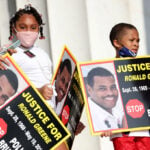 US won't seek charges in unarmed Black motorist Ronald Greene's fatal 2019 arrest
US won't seek charges in unarmed Black motorist Ronald Greene's fatal 2019 arrest
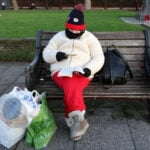 Euro zone households could increase consumption, ECB chief economist says
Euro zone households could increase consumption, ECB chief economist says
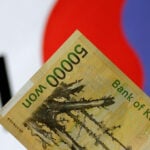 Foreigners sold South Korean equities last month by most since early 2020
Foreigners sold South Korean equities last month by most since early 2020
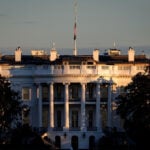 Trump and Biden national and homeland security staff will meet Wednesday for threat exercises
Trump and Biden national and homeland security staff will meet Wednesday for threat exercises
 As fires ravage Los Angeles, Tiger Woods isn't sure what will happen with Riviera tournament
As fires ravage Los Angeles, Tiger Woods isn't sure what will happen with Riviera tournament
 Antetokounmpo gets 50th career triple-double as Bucks win 130-115 to end Kings' 7-game win streak
Antetokounmpo gets 50th career triple-double as Bucks win 130-115 to end Kings' 7-game win streak
 No 97 Laura Siegemund upsets Olympic champion Zheng Qinwen at the Australian Open
No 97 Laura Siegemund upsets Olympic champion Zheng Qinwen at the Australian Open
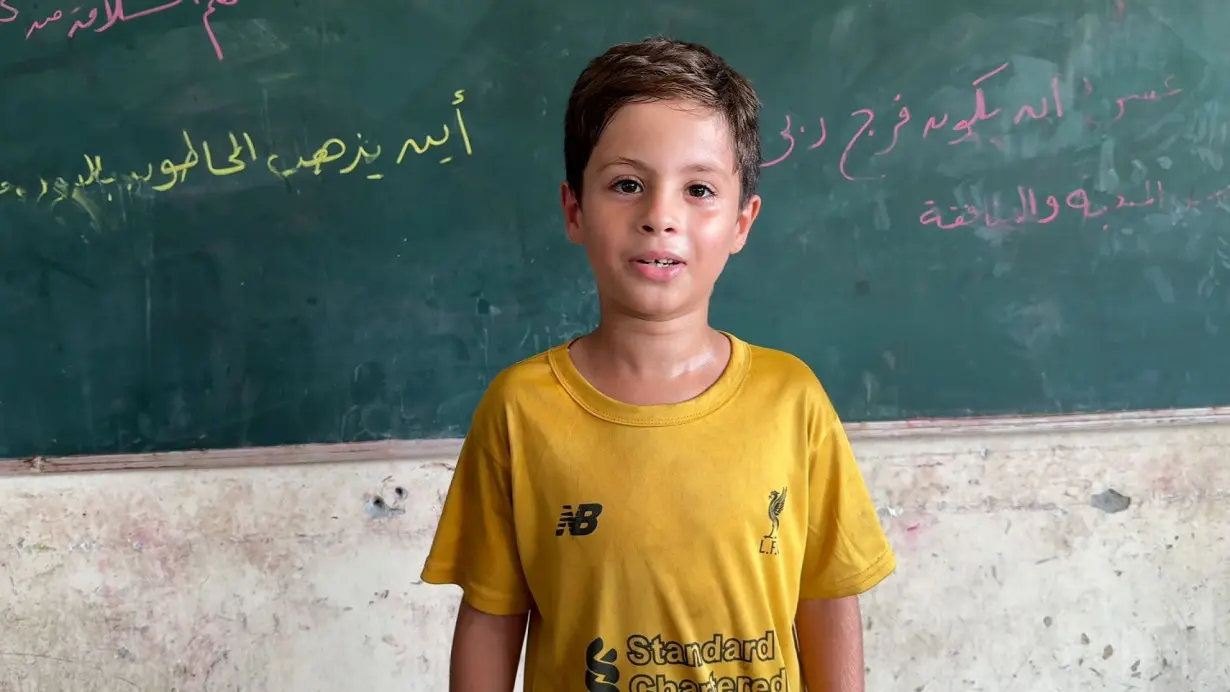 CNN via CNN Newsource
CNN via CNN Newsource

